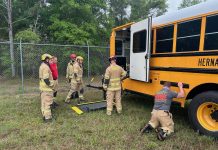For student transportation directors, there is nothing better than ending the school year with an improved safety record. Patrick Starken of Racine (Wisc.) Unified School District told STN he was “really excited” to learn that, with the help of contractor Durham School Services, the number of bus accidents dropped once again.
From the 2007-2008 through the 2012-2013 school year, the rate has declined from 75 to 24 — or 66 percent overall.
Starken breaks it down even further: Of those 24 accidents, just about half were labeled “unpreventable,” which means the school bus was parked and struck by another vehicle.
“We actually had 11 preventable accidents last year, which is absolutely remarkable — 13 last year— and 13 that were unpreventable,” said Starken, who joined the district in 2007. “I’m so happy with the drivers and how they keep the kids safe — it’s awesome.”
The first number is even more noteworthy, he added, considering the Racine district is 100 square miles and his 150 buses travel 4 million miles a year. His department serves about 11,000 riders, approximately half of all students.
Starken attributes their ever-improving safety record to Durham’s driver training programs, experienced operators and efforts to keep them on the same routes.
Craig Sable has been the safety and training supervisor at Durham for nine years, and he is also a third party examiner for Wisconsin’s Department of Transportation, so he tests drivers throughout the state.
“When I’m riding with the driver, I’m evaluating (him or her) based on the way I was trained by the state DOT,” Sable explained. “Most of our drivers have been here more than 10 years. We constantly stress to drivers at monthly safety meetings to look ahead, look around, leave room and communicate.”
Starken said he attends the monthly safety meetings because he agrees that openly communicating with bus drivers is essential. He said there are two things he asks of all the drivers: Get the kids to school safely, and follow the run directions he created with Durham’s bus manager, Gail Bergstrom.
When he was hired six years ago, Starken recalled the first change he made was to consolidate bus stops, dropping many of the 1,500 stops, which saved 300 miles a day. This not only reduced the transportation budget, but he said it also played a role in reducing bus accidents.
“There were three steps: bus stop consolidation, which meant using more of the main roads and not driving directly into neighborhoods; moving to a three-tiered busing system; … and strategically placing our standby drivers on the north side, south side and middle of the district [for] a quick response if there is an issue,” he continued.
Sable noted that Durham tracks all bus driver accidents, and particularly the types of accidents, to find common causes and take preventative steps, like reminding drivers to just stop their vehicle if they are not sure they can fit down a street or execute a tight turn.
“We have very few accidents that are caused by inattentive driving. I think it’s because of our constant reinforcement. At our safety meetings, we review the accidents we had that month and what the root cause of it was,” said Sable. “We also have a board where we post daily how many accident-free days we’ve had. As of today, we have 92 — that’s the highest it’s ever been.”















